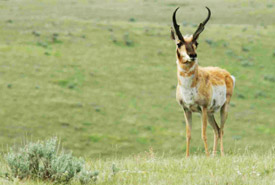Pronghorns: A sure-footed alarm whistle for Canada's Prairies

Pronghorn antelope, Old Man on His Back (Photo by Karol Dabbs)
Growing up on a ranch in the short-grass prairie region of southern Alberta, I had early exposure to the natural world and some of Canada’s most unique and charismatic wildlife species. From the resilient coyote, to the secretive badger, the majestic ferruginous hawk to the nocturnal Ord’s kangaroo rat, the nonvenomous bullsnake to the Great Plains toad — there is no shortage of fascinating wildlife on the Canadian prairies.
One species, however, has always caught my attention and foremost interest. The pronghorn (Antilocapra americana) is an even-toed ungulate that is indigenous to the interior western and central North America. More than that, it is a quirky, flight-footed alarm whistle for the prairies.
Pronghorns are easily distinguished from other Canadian ungulates by their unique markings and appearance. Both males and females stand approximately 32-41 inches tall and weigh anywhere from 34 to 65 kilograms, with the males being larger. Pronghorn coats are reddish brown with white on their rumps, sides, breasts, bellies and throats. They have prominent eye sockets set high on the skull.
Pronghorns have unique horn sheaths, which is different than the antlers of deer or the true horns of cattle or bison. True horns are unbranched, made of keratin (compressed hair) and are never shed. Antlers are made of bone and are shed annually. Pronghorn horn sheaths are branched in males, shed annually and made of keratin growing on a bony core. Both female and males have horn sheaths, which do not technically qualify fully as horns or antlers.
Aside from its appearance and size, the survival characteristics of the pronghorn make it distinct from other Canadian mammals. Pronghorns can sprint as fast as 100 kilometres per hour and can sustain a speed of 55 kilometres per hour for kilometres, making it arguably the fastest land mammal in the world! Only the cheetah can sprint faster than the pronghorn, however the pronghorn can sustain high speeds for longer.
Pronghorns typically give birth to twins, and these kids can walk within an hour and are able to outrun a human within a few days.
Along with their speed, pronghorns also have excellent vision and can pick up movement miles away. If a Pronghorn detects a threat, they have a variety of distinctive alarm calls they use to let fellow pronghorn know when to be on alert and when to run! These alarm whistles can sound almost bird-like, as a high-pitched "caw" or chuffing. It is not uncommon to see large groups running long distances across the prairie once they are alarmed — often resembling a flock of birds.
Contrary to common belief, the pronghorn is not a true antelope, as these are only found in Africa or Eurasia. It is the only surviving member of the family Antilocapridae, and has five subspecies throughout North America. Distribution occurs through the prairie regions in Canada in open, treeless areas including grasslands, brushlands and semi-desert regions. Pronghorns rely heavily on sagebrush for winter grazing and due to cultivation for agriculture, although much of this food source has been lost.
In the early 1900s pronghorns were once near extinction because of cultivation, climate change and habitat fragmentation. Currently, they are classified as sensitive in the General Status of Alberta Wild Species.
Unlike other Canadian ungulates, pronghorns do not jump fences — they crawl under if the fence structure allows.
The Nature Conservancy of Canada has actively been mitigating threats to pronghorns and other native species in Alberta by conserving lands of native grasslands and hosting fencing events where the bottom barbwire strand is removed and replaced with a higher smooth wire that allows pronghorn to pass under unhindered.


